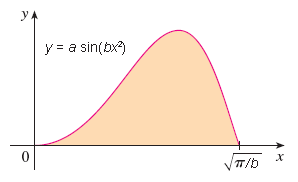
Nitai M. answered • 08/05/20
Dedicated Tutor for MCAT, USMLE, and Bio/Chem/Physics
To find the volume of the solid that results from rotating the function about the y-axis, we will create many 3D shells, find the volume of each one, and add them all together. Actually, the process boils down to expressing a general 3D shell as a function, and then integrating the function over the interval of x seen in the graph.
Each shell's volume can be found by multiplying (1) its circumference, (2) its height, and (3) its width.
The circumference of each shell is
C = 2πr where the radius is equal to x.
Thus,
C = 2πx
The height of each shell is equal to f(x), which is given.
h(x) = f(x) = 6sin(3x2)
Finally, the width of each shell is simply
width = dx
(Each shell is made up of a rectangle of width = dx and height = f(x) that is rotated about the y-axis at a circumference, 2πx.)
To find the volume, all we have to do is multiply the three parameters (height, width, and circumference) and integrate over the interval x = [ 0, √(π/3) ].
V = ∫ (2πx)*f(x) (dx) evaluated over the interval [ 0, √(π/3) ]
V = 2π ∫ (x) (6)sin(3x2) ( (dx)
V = 2π ∫ (6x) sin(3x2) (dx)
V = 2π * [ -cos(3x2) ] 0√(π/3)
V = 2π * [ -cos(3(π/3)) - (-cos(0)) ]
V = 2π * [ -cos(π) + cos(0) ]
V = 2π * (1 + 1)
V = 4π






